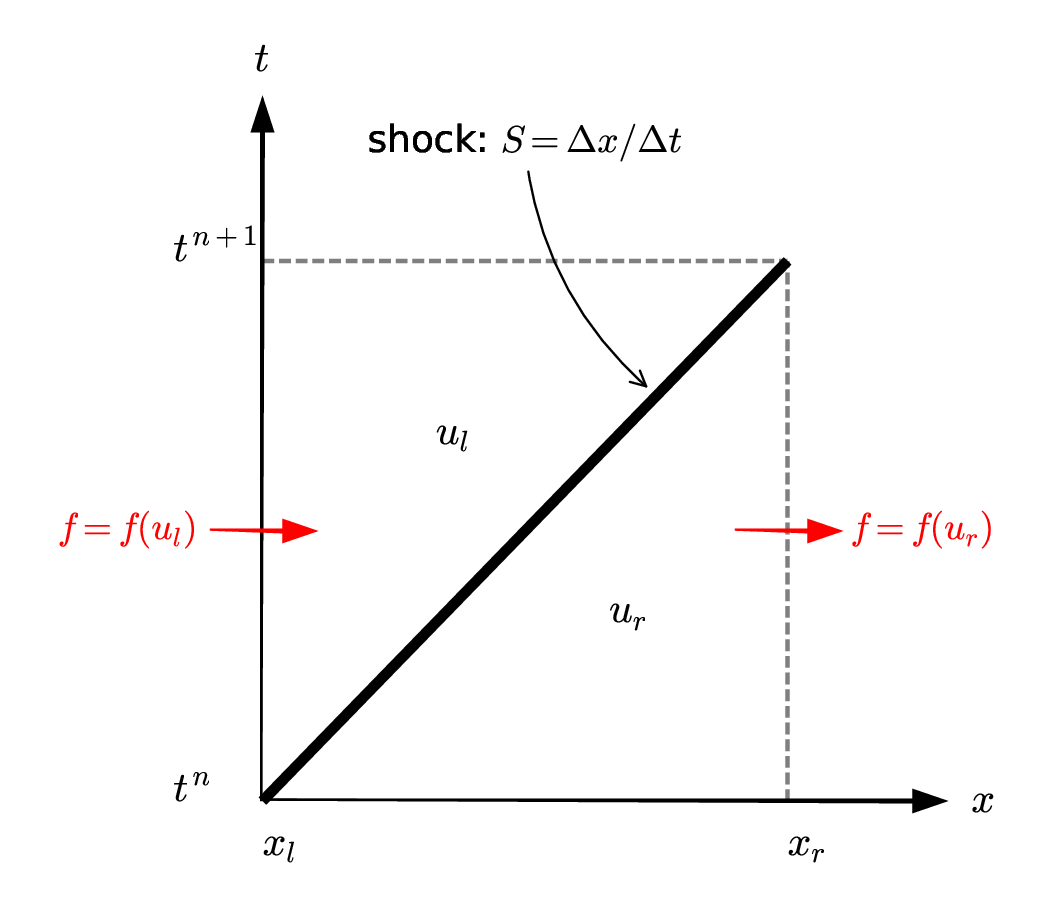Burgers’ Riemann Problem#
As discussed with advection, the physics of the equation comes into play when we determine what the correct state is on the interface given a left and right state. This is the Riemann problem. For Burgers’ equation, this Riemann problem is more complex.
Shock speed#
If the characteristics intersect in the \(x\)-\(t\) plane, then it is not possible to trace backwards in time to see where the information came from—this is the condition of a shock. The shock speed is computed through the Rankine-Hugoniot jump conditions.
Consider the following space-time diagram:

Fig. 4 A rightward moving shock in the \(x\)-\(t\) plane separating two state#
This shows a left and right state, \(u_l\) and \(u_r\), separated by a rightward moving shock in the \(x\)-\(t\) plane (the dark line). Notice that:
At time \(t^n\), the state in our integral \(x \in [x_l, x_r]\) is entirely \(u_r\).
As time evolves (think about moving upward in this figure), the state becomes a mix of states \(u_l\) and \(u_r\).
Finally at time \(t^{n+1}\) the state is entirely \(u_l\) in \(x \in [x_l, x_r]\).
The shock speed is clearly \(S = \Delta x / \Delta t\) in this figure.
To determine the speed, we start with Burgers’ equation in conservative form:
and integrate our conservation law over space and time (and normalize by \(\Delta x\)):
Recognizing that at \(t = t^n\), \(u = u_r\) and at \(t = t^{n+1}\), \(u = u_l\), the left side becomes:
Now for the right side. We see that all along \(x = x_l\), the flux is \(f = f(u_l)\) for \(t \in [t^n, t^{n+1}]\). Likewise, all along \(x = x_r\), the flux is \(f = f(u_r)\) in the same time interval. Therefore, our expression becomes:
Using \(S = \Delta x/\Delta t\), we see:
and taking \(f(u) = u^2 / 2\), we get:
Sampling the solution#
Now that we understand the shock speed, we need to determine what the state is on the interface.
For an interface in our domain, \(u_{i+1/2}\), we need to solve the Riemann problem \(u_{i+1/2} = \mathcal{R}(u_{i+1/2,L}, u_{i+1/2,R})\). We do this first by looking at whether the flow is converging or diverging. For converging flow, \(u_{i+1/2,L} > u_{i+1/2,R}\), we need to consider a shock; otherwise we consider a rarefaction. We write this as:
where \(u_s\) is the shock case and \(u_r\) is the rarefaction case.
For the shock, we look at the direction the shock is moving and choose the appropriate state:
For the rarefaction, we do:
